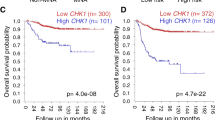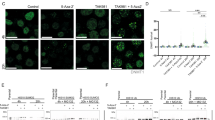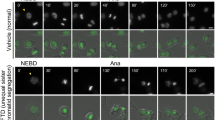Abstract
CHK1 and CHK2 function as effectors of cell cycle checkpoint arrest following DNA damage. Small molecule inhibitors of CHK proteins are under clinical evaluation in combination with chemotherapeutic agents known to induce DNA damage. We examined whether CHK inhibitors could be effective as single agents in malignant cells with inherent DNA damage because of deregulated expression of the oncogene c-Myc. Eμ-myc lymphoma cells showed a dramatic increase in the extent of DNA damage and DNA damage response (DDR) signalling within 1 h of treatment with CHK1 inhibitors followed by caspase-dependent apoptosis and cell death. In p53 wild-type/ARF null Eμ-myc lymphoma cells, apoptotic cell death was preceded by accumulation of DNA damage and the amount of DNA damage correlated with the extent of cell death. This effect was not observed in normal B cells indicating that DNA damage accumulation following CHK inhibition was specific to Eμ-myc lymphoma cells that exhibit inherent DNA damage because of MYC-induced replication stress. Similar results were obtained with another structurally distinct CHK-inhibitor. Eμ-myc p53 null lymphoma cells were more sensitive to a dual CHK1/CHK2 inhibitor than to a CHK1-specific inhibitor. In all cases, the level of DNA damage following treatment was the most consistent indicator of drug sensitivity. Our results suggest that CHK inhibitors would be beneficial therapeutic agents in MYC-driven cancers. We propose that inhibitors of CHK can act in a synthetically lethal manner in cancers with replication stress as a result of these cancers being reliant on CHK proteins for an effective DDR and cell survival.
This is a preview of subscription content, access via your institution
Access options
Subscribe to this journal
Receive 50 print issues and online access
$259.00 per year
only $5.18 per issue
Buy this article
- Purchase on SpringerLink
- Instant access to full article PDF
Prices may be subject to local taxes which are calculated during checkout







Similar content being viewed by others
References
Abulaiti A, Fikaris AJ, Tsygankova OM, Meinkoth JL . (2006). Ras induces chromosome instability and abrogation of the DNA damage response. Cancer Res 66: 10505–10512.
Adams JM, Harris AW, Pinkert CA, Corcoran LM, Alexander WS, Cory S et al. (1985). The c-myc oncogene driven by immunoglobulin enhancers induces lymphoid malignancy in transgenic mice. Nature 318: 533–538.
Ashwell S, Zabludoff S . (2008). DNA damage detection and repair pathways—recent advances with inhibitors of checkpoint kinases in cancer therapy. Clin Cancer Res 14: 4032–4037.
Bartek J, Bartkova J, Lukas J . (2007). DNA damage signalling guards against activated oncogenes and tumour progression. Oncogene 26: 7773–7779.
Bartek J, Lukas J . (2003). Chk1 and Chk2 kinases in checkpoint control and cancer. Cancer Cell 3: 421–429.
Bartkova J, Horejsi Z, Koed K, Kramer A, Tort F, Zieger K et al. (2005). DNA damage response as a candidate anti-cancer barrier in early human tumorigenesis. Nature 434: 864–870.
Bartkova J, Rezaei N, Liontos M, Karakaidos P, Kletsas D, Issaeva N et al. (2006). Oncogene-induced senescence is part of the tumorigenesis barrier imposed by DNA damage checkpoints. Nature 444: 633–637.
Bertwistle D, Sherr CJ . (2007). Regulation of the Arf tumor suppressor in Eμ-Myc transgenic mice: longitudinal study of Myc-induced lymphomagenesis. Blood 109: 792–794.
Blasina A, Hallin J, Chen E, Arango ME, Kraynov E, Register J et al. (2008). Breaching the DNA damage checkpoint via PF-00477736, a novel small-molecule inhibitor of checkpoint kinase 1. Mol Cancer Ther 7: 2394–2404.
Braig M, Lee S, Loddenkemper C, Rudolph C, Peters AH, Schlegelberger B et al. (2005). Oncogene-induced senescence as an initial barrier in lymphoma development. Nature 436: 660–665.
Chanoux RA, Yin B, Urtishak KA, Asare A, Bassing CH, Brown EJ . (2009). ATR and H2AX cooperate in maintaining genome stability under replication stress. J Biol Chem 284: 5994–6003.
Cole KA, Huggins J, Laquaglia M, Hulderman CE, Russell MR, Bosse K et al. (2011). RNAi screen of the protein kinome identifies checkpoint kinase 1 (CHK1) as a therapeutic target in neuroblastoma. Proc Natl Acad Sci U S A 108: 3336–3341.
Dai Y, Grant S . (2010). New insights into checkpoint kinase 1 in the DNA damage response signaling network. Clin Cancer Res 16: 376–383.
Deans AJ, Khanna KK, McNees CJ, Mercurio C, Heierhorst J, McArthur GA . (2006). Cyclin-dependent kinase 2 functions in normal DNA repair and is a therapeutic target in BRCA1-deficient cancers. Cancer Res 66: 8219–8226.
Di Micco R, Fumagalli M, Cicalese A, Piccinin S, Gasparini P, Luise C et al. (2006). Oncogene-induced senescence is a DNA damage response triggered by DNA hyper-replication. Nature 444: 638–642.
Dominguez-Sola D, Ying CY, Grandori C, Ruggiero L, Chen B, Li M et al. (2007). Non-transcriptional control of DNA replication by c-Myc. Nature 448: 445–451.
Eischen CM, Weber JD, Roussel MF, Sherr CJ, Cleveland JL . (1999). Disruption of the ARF-Mdm2-p53 tumor suppressor pathway in Myc-induced lymphomagenesis. Genes Dev 13: 2658–2669.
Enders GH . (2008). Expanded roles for Chk1 in genome maintenance. J Biol Chem 283: 17749–17752.
Giroux V, Iovanna J, Dagorn JC . (2006). Probing the human kinome for kinases involved in pancreatic cancer cell survival and gemcitabine resistance. FASEB J 20: 1982–1991.
Halazonetis TD, Gorgoulis VG, Bartek J . (2008). An oncogene-induced DNA damage model for cancer development. Science 319: 1352–1355.
Hickson I, Zhao Y, Richardson CJ, Green SJ, Martin NM, Orr AI et al. (2004). Identification and characterization of a novel and specific inhibitor of the ataxia-telangiectasia mutated kinase ATM. Cancer Res 64: 9152–9159.
Janetka JW, Ashwell S, Zabludoff S, Lyne P . (2007). Inhibitors of checkpoint kinases: from discovery to the clinic. Curr Opin Drug Discov Devel 10: 473–486.
Kastan MB . (2008). DNA damage responses: mechanisms and roles in human disease: 2007 G.H.A. Clowes Memorial Award Lecture. Mol Cancer Res 6: 517–524.
Lindemann RK, Newbold A, Whitecross KF, Cluse LA, Frew AJ, Ellis L et al. (2007). Analysis of the apoptotic and therapeutic activities of histone deacetylase inhibitors by using a mouse model of B cell lymphoma. Proc Natl Acad Sci U S A 104: 8071–8076.
Liu Q, Guntuku S, Cui XS, Matsuoka S, Cortez D, Tamai K et al. (2000). Chk1 is an essential kinase that is regulated by Atr and required for the G(2)/M DNA damage checkpoint. Genes Dev 14: 1448–1459.
Lord CJ, Ashworth A . (2009). Bringing DNA repair in tumors into focus. Clin Cancer Res 15: 3241–3243.
Lotem J, Sachs L . (1993). Hematopoietic cells from mice deficient in wild-type p53 are more resistant to induction of apoptosis by some agents. Blood 82: 1092–1096.
Mallette FA, Ferbeyre G . (2007). The DNA damage signaling pathway connects oncogenic stress to cellular senescence. Cell Cycle 6: 1831–1836.
Mallette FA, Gaumont-Leclerc MF, Ferbeyre G . (2007). The DNA damage signaling pathway is a critical mediator of oncogene-induced senescence. Genes Dev 21: 43–48.
Mercurio C, Pastori S, Crippa R, Alzani R, Albanese M, Muzio M et al. (2004). In vitro and in vivo characterization of the CDK inhibitor PHA-533533. Proc Am Assoc Cancer Res 45: 190.
Morgan MA, Parsels LA, Zhao L, Parsels JD, Davis MA, Hassan MC et al. (2010). Mechanism of radiosensitization by the Chk1/2 inhibitor AZD7762 involves abrogation of the G2 checkpoint and inhibition of homologous recombinational DNA repair. Cancer Res 70: 4972–4981.
Myers K, Gagou ME, Zuazua-Villar P, Rodriguez R, Meuth M . (2009). ATR and Chk1 suppress a caspase-3-dependent apoptotic response following DNA replication stress. PLoS Genet 5: e1000324.
Negrini S, Gorgoulis VG, Halazonetis TD . (2010). Genomic instability—an evolving hallmark of cancer. Nat Rev Mol Cell Biol 11: 220–228.
Newbold A, Lindemann RK, Cluse LA, Whitecross KF, Dear AE, Johnstone RW . (2008). Characterisation of the novel apoptotic and therapeutic activities of the histone deacetylase inhibitor romidepsin. Mol Cancer Ther 7: 1066–1079.
Nguyen M, Marcellus RC, Roulston A, Watson M, Serfass L, Murthy Madiraju SR et al. (2007). Small molecule obatoclax (GX15-070) antagonizes MCL-1 and overcomes MCL-1-mediated resistance to apoptosis. Proc Natl Acad Sci U S A 104: 19512–19517.
Parsels LA, Morgan MA, Tanska DM, Parsels JD, Palmer BD, Booth RJ et al. (2009). Gemcitabine sensitization by checkpoint kinase 1 inhibition correlates with inhibition of a Rad51 DNA damage response in pancreatic cancer cells. Mol Cancer Ther 8: 45–54.
R DCT (2009). R: A language and environment for statistical computing. R Foundation for Statistical Computing V: Austria, URLhttp://www.R-project.orgISBN 3-900051-07-0.
Redon CE, Nakamura AJ, Zhang YW, Ji JJ, Bonner WM, Kinders RJ et al. (2010). Histone gammaH2AX and poly(ADP-ribose) as clinical pharmacodynamic biomarkers. Clin Cancer Res 16: 4532–4542.
Reimann M, Loddenkemper C, Rudolph C, Schildhauer I, Teichmann B, Stein H et al. (2007). The Myc-evoked DNA damage response accounts for treatment resistance in primary lymphomas in vivo. Blood 110: 2996–3004.
Reinhardt HC, Aslanian AS, Lees JA, Yaffe MB . (2007). p53-deficient cells rely on ATM- and ATR-mediated checkpoint signaling through the p38MAPK/MK2 pathway for survival after DNA damage. Cancer Cell 11: 175–189.
Schmitt CA, Fridman JS, Yang M, Lee S, Baranov E, Hoffman RM et al. (2002). A senescence program controlled by p53 and p16INK4a contributes to the outcome of cancer therapy. Cell 109: 335–346.
Sidi S, Sanda T, Kennedy RD, Hagen AT, Jette CA, Hoffmans R et al. (2008). Chk1 suppresses a caspase-2 apoptotic response to DNA damage that bypasses p53, Bcl-2, and caspase-3. Cell 133: 864–877.
Spurr AR . (1969). A low-viscosity epoxy resin embedding medium for electron microscopy. J Ultrastruct Res 26: 31–43.
Vafa O, Wade M, Kern S, Beeche M, Pandita TK, Hampton GM et al. (2002). c-Myc can induce DNA damage, increase reactive oxygen species, and mitigate p53 function: a mechanism for oncogene-induced genetic instability. Mol Cell 9: 1031–1044.
Wall M, Poortinga G, Hannan KM, Pearson RB, Hannan RD, McArthur GA . (2008). Translational control of c-MYC by rapamycin promotes terminal myeloid differentiation. Blood 112: 2305–2317.
Wilsker D, Petermann E, Helleday T, Bunz F . (2008). Essential function of Chk1 can be uncoupled from DNA damage checkpoint and replication control. Proc Natl Acad Sci USA 105: 20752–20757.
Xiao Z, Xue J, Sowin TJ, Zhang H . (2006). Differential roles of checkpoint kinase 1, checkpoint kinase 2, and mitogen-activated protein kinase-activated protein kinase 2 in mediating DNA damage-induced cell cycle arrest: implications for cancer therapy. Mol Cancer Ther 5: 1935–1943.
Zabludoff SD, Deng C, Grondine MR, Sheehy AM, Ashwell S, Caleb BL et al. (2008). AZD7762, a novel checkpoint kinase inhibitor, drives checkpoint abrogation and potentiates DNA-targeted therapies. Mol Cancer Ther 7: 2955–2966.
Zenvirt S, Kravchenko-Balasha N, Levitzki A . (2010). Status of p53 in human cancer cells does not predict efficacy of CHK1 kinase inhibitors combined with chemotherapeutic agents. Oncogene 29: 6149–6159.
Zhao Y, Thomas HD, Batey MA, Cowell IG, Richardson CJ, Griffin RJ et al. (2006). Preclinical evaluation of a potent novel DNA-dependent protein kinase inhibitor NU7441. Cancer Res 66: 5354–5362.
Acknowledgements
This work was supported by grants from the National Health and Medical Research Council of Australia to GAM and to RWJ. GAM is a recipient of the Weary Dunlop Clinical Research Fellowship of the Cancer Council of Victoria. The statistical analysis and data presentation of dose response curves was performed by Dr Robert N Jorissen (LCCI, Ludwig Institute for Cancer Research). The MetaMorph Journal for measuring the Olive Tail Moment was provided by Cameron J Nowell of the Centre for Advanced Microscopy at the Ludwig Institute for Cancer Research. Pfizer Oncology, La Jolla, CA, USA provided PF-0477736 for this study. Dr Sreesha Srinivasa and Dr Wendy Levin (Pfizer Oncology) contributed to scientific discussion.
From the Peter MacCallum Cancer Centre, we thank Ralph Rossi (FACS core facility) for advice with flow cytometry; Steve Asquith and Karin Sedelies (Microscopy core facility) for assistance with transmission electron microscope (TEM) and fluorescence microscopy; Leonie Cluse, Richard Young and Dr Jeanette Raleigh for technical advice; Dr David Thomas for scientific suggestions; Megan Bywater, Kerry Ardley, Jeannette Valentan, Rachael Walker, Dr Carleen Cullinane and Dr Kathryn Kinross for technical assistance.
Author information
Authors and Affiliations
Corresponding author
Ethics declarations
Competing interests
GAM, PTF and RWJ receive research support from Pfizer Inc.
Additional information
Supplementary Information accompanies the paper on the Oncogene website
Supplementary information
Rights and permissions
About this article
Cite this article
Ferrao, P., Bukczynska, E., Johnstone, R. et al. Efficacy of CHK inhibitors as single agents in MYC-driven lymphoma cells. Oncogene 31, 1661–1672 (2012). https://doi.org/10.1038/onc.2011.358
Received:
Revised:
Accepted:
Published:
Issue Date:
DOI: https://doi.org/10.1038/onc.2011.358
Keywords
This article is cited by
-
Sensitivity of cells to ATR and CHK1 inhibitors requires hyperactivation of CDK2 rather than endogenous replication stress or ATM dysfunction
Scientific Reports (2021)
-
Comparison of the different mechanisms of cytotoxicity induced by checkpoint kinase I inhibitors when used as single agents or in combination with DNA damage
Oncogene (2020)
-
The therapeutic effectiveness of 177Lu-lilotomab in B-cell non-Hodgkin lymphoma involves modulation of G2/M cell cycle arrest
Leukemia (2020)
-
CHK1 dosage in germinal center B cells controls humoral immunity
Cell Death & Differentiation (2019)
-
Targeting oncogenic Myc as a strategy for cancer treatment
Signal Transduction and Targeted Therapy (2018)



